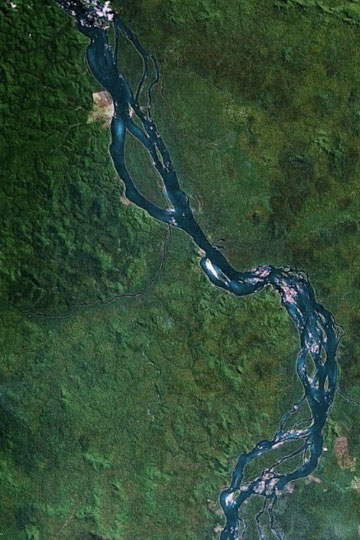Damming of the Xingu River has begun in Brazil to make way for the eventual construction of the hugely controversial, Belo Monte dam. The Norte Energia (NESA) consortium has begun building coffer dams across the Xingu, which will dry out parts of the river before permanent damming, reports the NGO International Rivers. Indigenous tribes, who have long opposed the dam plans on their ancestral river, conducted a peaceful protest that interrupted construction for a couple hours.
“We will continue to resist this monstrosity and work to call attention of the Brazilian public and the world that this wanton destruction of the Amazon will hurt us all,” said Antônia Melo, coordinator of the Xingu Vivo movement that organized the protest. “To take away the river is to take away the life of its people, because water is life.”
 A section of the Xingu River as viewed by Google Earth. |
Diverting 80 percent of the Xingu River’s flow, the Belo Monte dam is also expected to displace 16,000 people, according to the Brazilian government; although environmentalists estimate that 40,000 could be forced to move. Amazon Watch, a group campaigning against Belo Monte, says the dam will flood more than 40,000 hectares of rainforest. The issue has sparked considerable attention outside of Brazil with 600,000 people around the worldsigning a petition against the dam.
Indigenous tribes say they were not notified that Norte Energia (NESA) had begun constructing coffer dams until the river became red-colored with mud.
“When we learned what they were doing, it practically killed us with sadness,” Josinei Arara, a member of the Arara indigenous community 10 miles downstream on the Xingu from the Pimental dam site, told International Rivers. “The dam builders have kept none of their promises to compensate our village; in they meantime, they’re assassinating our river.”
The Brazilian government says the megadam must be built to meet the rising nation’s power needs. The dam would provide enough energy to power 23 million homes, yet during three to four months of the year critics say it will run on only 10-30 percent capacity due to low waters, an issue climate change will likely exacerbate.
Last November, a Brazilian court ruled that indigenous communities do not have a right to free, prior and informed consultation regarding the Belo Monte dam because it is physically located on tribal lands.
Related articles
Deforestation, climate change threaten the ecological resilience of the Amazon rainforest
(01/19/2012) The combination of deforestation, forest degradation, and the effects of climate change are weakening the resilience of the Amazon rainforest ecosystem, potentially leading to loss of carbon storage and changes in rainfall patterns and river discharge, finds a comprehensive review published in the journal Nature.
(11/09/2011) Indigenous communities do not have the right to free, prior and informed consultation on the Belo Monte dam because its infrastructure and reservoirs would not be physically located on tribal lands, ruled a Brazilian court.
Occupy Belo Monte: indigenous stage “permanent” protest against Amazon dam in Brazil
(10/27/2011) Hundreds of people are participating in a protest against the controversial Belo Monte dam in Altamira, Brazil, reports Amazon Watch.